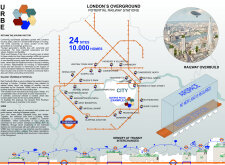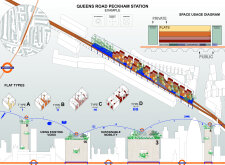5 key facts about this project
The URBE project offers a fresh approach to London’s housing challenges by integrating living spaces with the city’s railway system. Located in an area that experiences constant urban growth, it aims to redefine home ownership and facilitate a sense of community among residents. The overall design concept prioritizes connectivity, social interaction, and efficient use of space, addressing the ongoing housing crisis by reimagining how urban living can function.
Concept and Model
Traditional views of home ownership are changing, especially among younger people who value flexibility and community more than property. By proposing a housing model based on a subscription service, URBE provides an alternative to the conventional buying and renting systems. This structure allows local institutions to take responsibility for housing, which helps create a sense of community among residents and fosters social connections.
Rail Overbuild Strategy
The innovative use of airspace above railway lines forms the cornerstone of the URBE strategy. This Rail Overbuild concept aims to change how underused areas are perceived and transformed into vibrant living spaces. By developing above existing infrastructure, the project not only addresses the significant shortage of housing in London but also reconnects urban areas that were once divided by transportation networks. The result is enhanced mobility, encouraging both residents and visitors to navigate the city more easily.
Community Integration
Emphasizing the blending of private and public areas, the design incorporates spaces that encourage residents to meet and interact. Individual residential units are carefully planned within larger buildings, fostering a sense of belonging. This focus on communal living makes the idea of "URBEnity" come alive, as shared spaces play a crucial role in promoting relationships among neighbors. The layout motivates engagement and creates avenues for socializing.
Sustainability and Urban Density
URBE's strategy of utilizing airspace above railways allows for greater urban density without occupying additional land. This method is particularly significant in a city like London, where space is limited and highly valued. The thoughtful design aims not only to address housing needs but also to enhance the experience of urban living by ensuring that residential and communal spaces exist in harmony.
The residential buildings include communal areas designed to promote interaction. By doing so, the project underscores the importance of creating environments that encourage community living and offer opportunities for collaboration among residents.






















































